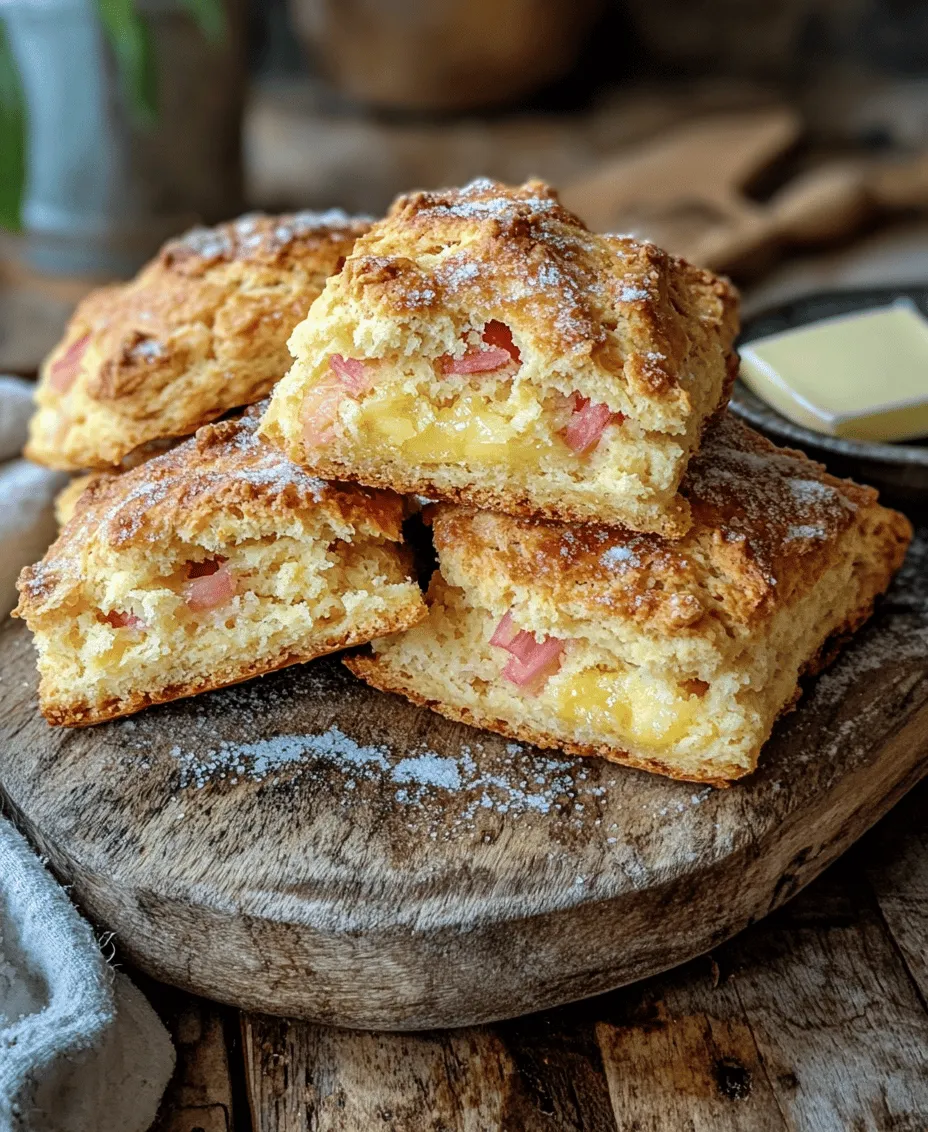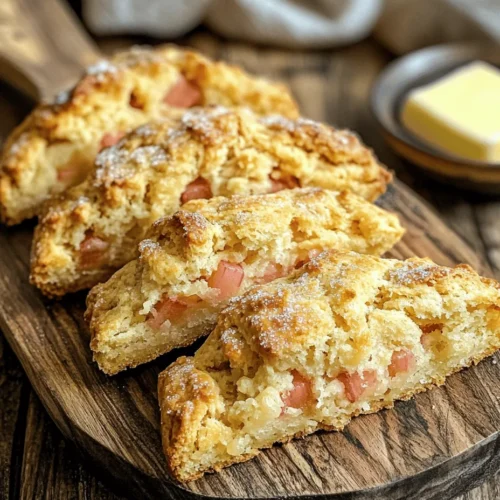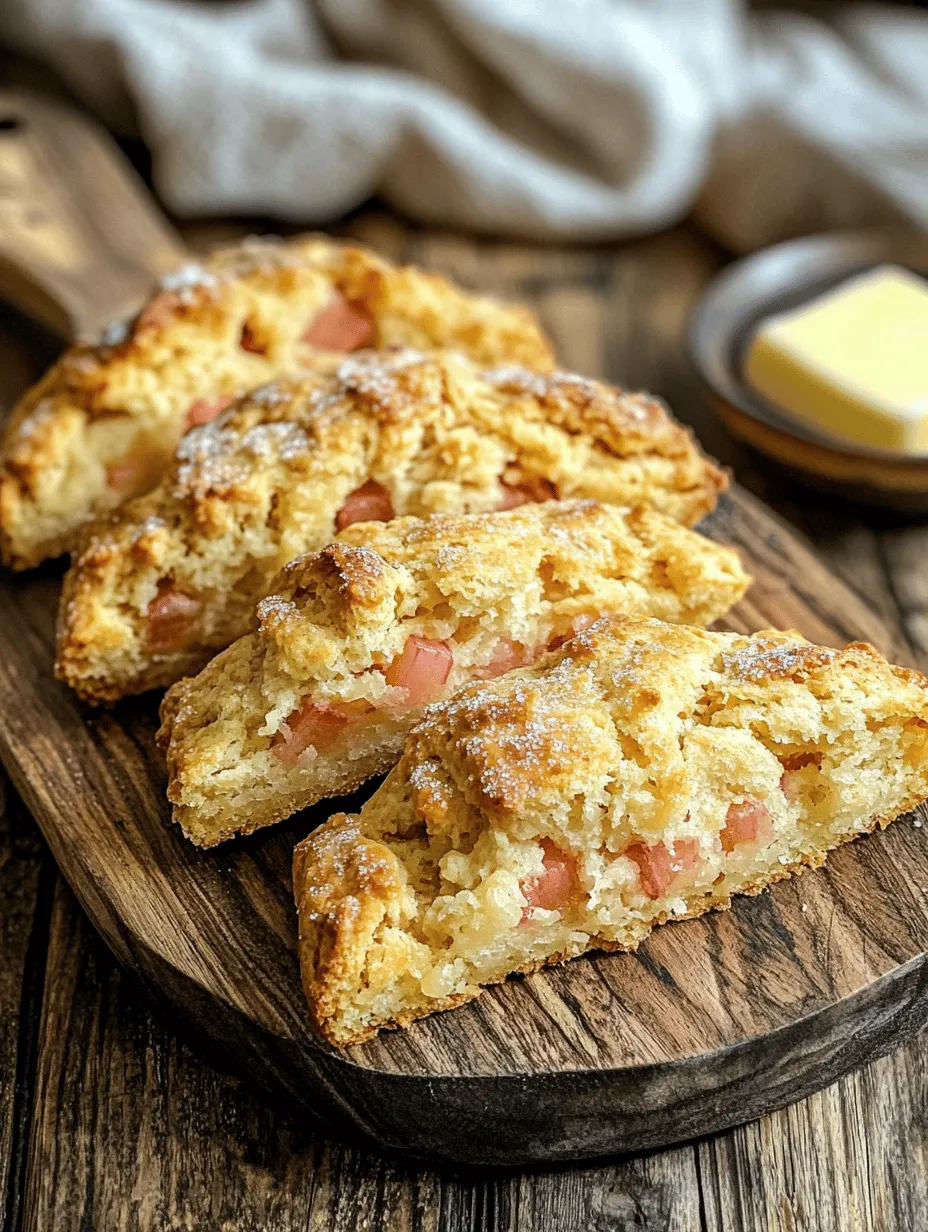Introduction
Welcome to the delightful world of baking, where the aroma of freshly baked goods can transform any ordinary day into an extraordinary experience. Today, we are excited to share a recipe that perfectly encapsulates the essence of springtime and the joy of using seasonal ingredients: Tangy Delight Rhubarb Scones. These delicious treats bring together the unmistakable tartness of rhubarb and the soft, buttery texture of a classic scone, making them a perfect addition to your breakfast table, a delightful brunch offering, or an elegant afternoon tea treat.
Rhubarb, often considered a vegetable but enjoyed as a fruit, lends a unique flavor profile that balances sweetness and tartness, elevating these scones to a whole new level. The bright pink stalks of rhubarb not only add a pop of color to your baked goods but also a depth of flavor that is both refreshing and tangy. In this article, we will delve into the fascinating characteristics of rhubarb, the rich tradition of scone-making, and guide you through the process of creating these delectable scones from scratch. Whether you’re a seasoned baker or a novice in the kitchen, you’ll find that these scones are not only easy to make but also incredibly satisfying to enjoy.
Get ready to embark on a culinary adventure as we explore the journey of creating scrumptious rhubarb scones that will leave family and friends clamoring for seconds. Let’s dive into the world of rhubarb, understand its unique attributes, and master the art of making perfect scones!
Understanding Rhubarb: A Unique Ingredient
The Flavor Profile of Rhubarb
Rhubarb is a distinctive ingredient, primarily known for its tart flavor, which can be an acquired taste for some. When raw, its sharp acidity is reminiscent of a sour green apple, which can be quite shocking. However, when cooked, rhubarb transforms. The heat mellows its tartness, allowing its natural sweetness to emerge, especially when paired with sugar. This duality makes rhubarb an exciting ingredient for baking, where it can cut through richer flavors and enhance the overall taste profile of desserts and pastries.
In the context of our Tangy Delight Rhubarb Scones, the rhubarb not only brings a refreshing tang but also moisture to the scone, enriching its texture. The combination of the scone’s buttery base with the bright flavor of rhubarb creates a delightful contrast that is both satisfying and memorable.
Health Benefits of Rhubarb
Beyond its culinary appeal, rhubarb is packed with health benefits. It is low in calories while being rich in vitamins and minerals. Rhubarb is an excellent source of vitamin K, which plays a crucial role in bone health, and vitamin C, known for its immune-boosting properties. Furthermore, it contains dietary fiber that aids digestion and can contribute to a feeling of fullness, making it a great addition to a balanced diet. Incorporating rhubarb into your baking not only adds flavor but also boosts the nutritional value of your treats.
Choosing Fresh vs. Frozen Rhubarb
When it comes to using rhubarb in recipes, you have the option of using fresh or frozen rhubarb. Fresh rhubarb is typically available in late spring through early summer. Look for firm, crisp stalks that are vibrant in color—preferably a deep pink or reddish hue. Avoid any stalks with signs of wilting or browning, as these may be past their prime.
On the other hand, frozen rhubarb is a convenient alternative that can be used year-round. If you choose to use frozen rhubarb, there’s no need to thaw it before adding it to your scone dough; just toss it in while still frozen to prevent the moisture from making the dough too wet. Regardless of which option you choose, both fresh and frozen rhubarb will yield delightful results in your scones.
The Art of Making Scones
A Brief History of Scones
Scones have a rich history that dates back to the early 16th century in Scotland, where they were typically made with oats and baked on a griddle. Over time, the recipe evolved, with the introduction of wheat flour and the addition of baking powder, leading to the light, fluffy texture we associate with modern scones. Traditionally enjoyed with tea, scones have become a staple of British cuisine, often served with clotted cream and jam.
Today, scones are enjoyed in various forms and flavors around the world. From sweet to savory, they can be customized to suit all palates. Incorporating seasonal ingredients like rhubarb into this classic recipe not only honors its history but also adds a creative twist that can elevate your baking repertoire.
Key Characteristics of Perfect Scones
Achieving the perfect scone involves understanding a few key characteristics that define their texture and flavor:
1. Light and Fluffy Texture: A great scone should be tender and airy, not dense or crumbly. This is achieved through the right balance of ingredients and proper mixing techniques.
2. Golden Brown Crust: The exterior of a scone should have a beautiful golden-brown hue, indicating that it has been baked to perfection. A good scone will have a crisp outer layer that contrasts with its soft interior.
3. Flavor Balance: While the primary flavor can vary, a perfect scone should have a balanced sweetness that complements its main ingredient. In our case, the tartness of rhubarb will shine through, creating a delightful contrast.
4. Moisture Content: A well-made scone should retain moisture, making each bite enjoyable without being overly wet. The addition of rhubarb not only enhances flavor but also contributes moisture.
Common Mistakes to Avoid When Baking Scones
To ensure that your Tangy Delight Rhubarb Scones turn out perfectly, it’s important to avoid some common pitfalls:
– Overmixing the Dough: One of the biggest mistakes when making scones is overmixing the dough. This can lead to tough scones instead of the tender texture we want. Mix until the ingredients are just combined.
– Not Chilling the Dough: Chilling the dough before baking helps the butter solidify, which contributes to a flaky texture. Don’t skip this step!
– Using the Wrong Flour: All-purpose flour is ideal for scone-making. Using a flour with too much protein can result in a dense scone.
– Ignoring Oven Temperature: Make sure your oven is preheated properly. An oven that’s too cool can prevent the scones from rising adequately, resulting in flat and dense baked goods.
With these tips in mind, you’re well on your way to mastering the art of scone-making!
Gathering Your Ingredients
Essential Ingredients for Rhubarb Scones
To create your Tangy Delight Rhubarb Scones, you will need the following ingredients:
1. All-Purpose Flour: The foundation of your scone, providing structure and texture.
2. Granulated Sugar: For sweetness, balancing the tartness of the rhubarb.
3. Baking Powder: A leavening agent that helps the scones rise and become fluffy.
4. Salt: Enhances the overall flavor and balances sweetness.
5. Unsalted Butter: Adds richness and moisture; should be cold and cut into small cubes.
6. Buttermilk: Contributes to the scone’s moisture and tangy flavor, helping to activate the baking powder.
7. Fresh or Frozen Rhubarb: The star ingredient that brings the delightful tang to the scones.
8. Optional Add-ins: Such as vanilla extract or lemon zest, to further enhance the flavor profile.
The Role of Each Ingredient in the Recipe
Understanding the role of each ingredient can help you feel more confident in your baking. Here’s a quick breakdown:
– Flour: Provides structure and acts as the main component of the dough.
– Sugar: Not only sweetens the scones but also aids in browning.
– Baking Powder: Responsible for the rise; make sure it’s fresh for the best results.
– Salt: Enhances flavors and balances sweetness.
– Butter: Adds flavor and creates a tender texture; cold butter creates steam as it melts, contributing to fluffiness.
– Buttermilk: Activates the baking powder and provides acidity, resulting in a tender crumb.
– Rhubarb: Infuses the scones with tart flavor and moisture.
Substitutions and Variations for Dietary Needs
If you have dietary restrictions or preferences, there are several substitutions you can make while still achieving delicious scones:
– Gluten-Free Flour: If you need a gluten-free option, use a 1:1 gluten-free flour blend that includes xanthan gum.
– Dairy-Free Butter: Substitute with a plant-based butter alternative and use non-dairy milk in place of buttermilk.
– Sweeteners: You can use coconut sugar or maple syrup to replace granulated sugar if preferred.
These variations ensure that everyone can enjoy a piece of Tangy Delight Rhubarb Scones, regardless of dietary needs.
Step-by-Step Instructions
Prepping Your Kitchen for Scone Making
Before diving into the baking process, it’s important to prepare your kitchen to ensure a smooth experience. Here’s how to get started:
1. Gather Your Tools: Assemble the necessary tools, including a mixing bowl, measuring cups and spoons, a pastry cutter or fork, a baking sheet, and parchment paper.
2. Preheat the Oven: Preheat your oven to 400°F (200°C) to ensure it’s hot enough to create the perfect scone texture.
3. Prepare Your Baking Sheet: Line a baking sheet with parchment paper to prevent sticking and make cleanup easier.
4. Chill Your Ingredients: If you have time, place your butter in the freezer for about 10 minutes before starting. Cold ingredients are essential for achieving a flaky texture in scones.
Mixing the Dry Ingredients: Flour, Sugar, and More
Once your kitchen is prepped and your ingredients are ready, it’s time to mix the dry ingredients:
1. Combine Flour and Sugar: In a large mixing bowl, whisk together 2 cups of all-purpose flour and 1/4 cup of granulated sugar. This will ensure that the sugar is evenly distributed throughout the flour.
2. Add Baking Powder and Salt: Next, add 1 tablespoon of baking powder and 1/2 teaspoon of salt to the flour mixture. Whisk again to combine, ensuring that all dry ingredients are well mixed.
3. Cut in the Butter: Take your chilled, cubed butter (1/2 cup) and add it to the flour mixture. Using a pastry cutter or your fingers, cut the butter into the flour until the mixture resembles coarse crumbs. This step is crucial; you want small pieces of butter to remain in the mixture, as they will create pockets of steam and contribute to the scone’s flakiness.
As you prepare to add the wet ingredients and rhubarb in the next steps, remember that the success of your Tangy Delight Rhubarb Scones lies in the careful balance of ingredients and techniques. Stay tuned for the continuation of this delicious recipe that will have you baking like a pro in no time.

Incorporating Butter: Achieving the Right Texture
The type of butter you use in your Rhubarb Scones plays a crucial role in creating the desired texture. For the best results, use unsalted butter that is cold or even slightly frozen. This ensures that when the butter is cut into the dry ingredients, it forms small, pea-sized pieces that will create pockets of steam as they bake. These pockets are what give scones their characteristic flaky texture.
Begin by cutting the cold butter into small cubes and adding it to the flour mixture. Using a pastry cutter or your fingertips, gently work the butter into the flour until the mixture resembles coarse crumbs. Be careful not to overwork the dough; the goal is to keep the butter pieces intact for those delightful, flaky layers.
Adding Rhubarb: Folding vs. Mixing
Once your butter is incorporated, it’s time to fold in the star ingredient: rhubarb. The way you add rhubarb can significantly affect the final product. Instead of mixing the rhubarb into the dough aggressively, try folding it in gently. This technique helps preserve the integrity of the rhubarb pieces and prevents them from becoming mushy.
First, chop your rhubarb into small, uniform pieces, about half an inch long. After the flour, butter, and sugar mixture is ready, create a well in the center and add the chopped rhubarb. Using a spatula, gently fold the rhubarb into the mixture until it’s just combined. This method ensures that the tangy flavor of the rhubarb is evenly distributed without crushing the fruit.
Combining Wet Ingredients: The Importance of Buttermilk
Buttermilk is a key ingredient in this scone recipe, contributing both moisture and a subtle tang that complements the rhubarb’s natural acidity. If you don’t have buttermilk on hand, you can easily make a substitute by adding one tablespoon of vinegar or lemon juice to one cup of milk and letting it sit for about 5-10 minutes until it curdles.
Once your dry ingredients and rhubarb are combined, it’s time to add the wet mixture. In a separate bowl, whisk together the buttermilk and an egg until well combined. Pour the buttermilk mixture into the flour and rhubarb mixture. Using a spatula, gently stir until the dough just comes together. Avoid overmixing, as this can lead to tough scones.
Bringing It All Together: Kneading and Shaping the Dough
After combining the wet and dry ingredients, turn the dough out onto a lightly floured surface. Gently knead it a few times—just enough to bring it together. This should take no more than 5-6 turns. Over-kneading can develop gluten, which will result in denser scones rather than the light, airy texture we desire.
Once kneaded, shape the dough into a circle about 1-inch thick. Use a sharp knife or pastry cutter to divide the dough into wedges, like slicing a pizza. Alternatively, you can use a round cutter for perfectly shaped scones. If you choose this method, just be sure to push the cutter straight down without twisting, which can seal the edges and prevent proper rising.
Cutting and Placing Scones on the Baking Sheet
When cutting your scones, make sure to place them on a lined baking sheet with some space between each piece. This allows for even baking and prevents them from sticking together. If you prefer a more rustic look, you can simply place the wedges directly onto the baking sheet.
For a polished finish, consider chilling the scones in the refrigerator for about 20 minutes before baking. Chilling helps them hold their shape and develop a nice rise in the oven.
The Finishing Touch: Egg Wash and Turbinado Sugar
To give your scones a beautiful golden-brown color, an egg wash is essential. This step not only enhances the visual appeal but also adds a lovely sheen. To make an egg wash, beat one egg with a splash of milk or water, then brush the mixture gently over the top of each scone.
For an additional touch of sweetness and crunch, sprinkle turbinado sugar on top of the egg wash before baking. This coarse sugar will caramelize slightly in the oven, creating a delightful contrast to the soft interior of the scones.
Baking Time: What to Look For
Preheat your oven to 400°F (200°C) and bake the scones for about 15-20 minutes, or until they are golden brown on top and a toothpick inserted into the center comes out clean. Keep an eye on them during the last few minutes of baking to prevent over-browning. The scones should feel light and airy when lifted.
Once out of the oven, allow them to cool on the baking sheet for a few minutes before transferring them to a wire rack. This step is crucial as it helps prevent sogginess on the bottom while allowing the steam to escape.
Serving Suggestions and Pairings
Best Ways to Serve Rhubarb Scones
Rhubarb scones are delightful on their own, but they can be elevated with a few simple accompaniments. Serve them warm, straight from the oven, for the best experience. You can also slice them in half to reveal their tender crumb and fill them with your favorite spreads.
Delicious Spreads: Butter, Clotted Cream, and More
Classic accompaniments for scones include a pat of softened butter, which melts beautifully into the warm scone. For a more indulgent option, consider clotted cream, which adds a rich, creamy texture that pairs perfectly with the tangy rhubarb.
You can also serve them with fruit preserves, particularly strawberry or raspberry, which complement the tartness of the rhubarb. A drizzle of honey can also add a lovely touch of sweetness.
Beverage Pairings: Tea, Coffee, and Refreshing Drinks
To enhance your scone experience, pair them with a warm cup of tea, such as Earl Grey or English Breakfast, which provides a robust contrast to the scones. For coffee lovers, a light roast coffee can bring out the subtle flavors of the scones without overwhelming them.
If you’re looking for something refreshing, consider serving the scones with a sparkling herbal tea or lemonade, particularly during warmer months.
Storing and Reheating Rhubarb Scones
How to Store Scones for Maximum Freshness
To keep your rhubarb scones fresh, store them in an airtight container at room temperature for up to two days. If you live in a particularly humid climate, consider refrigerating them to prolong their shelf life.
If you want to store them for longer, you can freeze the scones. Allow them to cool completely before wrapping them tightly in plastic wrap and placing them in a freezer-safe bag. They can be frozen for up to three months.
Reheating Tips for Enjoying Leftovers
To enjoy your leftover scones, preheat your oven to 350°F (175°C). Place the scones on a baking sheet and cover them loosely with aluminum foil to prevent over-browning. Heat them in the oven for about 10-15 minutes, or until warmed through. This method will help restore their softness and flaky texture.
Freezing Scones for Future Enjoyment
If you want to prepare scones in advance, you can freeze the unbaked dough. After shaping the scones, place them on a lined baking sheet and freeze until solid. Once frozen, transfer them to a freezer-safe bag. When you’re ready to bake, there’s no need to thaw; just add a few extra minutes to the baking time.
Conclusion
In conclusion, Tangy Delight Rhubarb Scones are not only a treat for the taste buds but also a wonderful way to experiment with seasonal ingredients. With their tender crumb and delightful tang, these scones are a perfect addition to any meal or gathering. Whether you’re a seasoned baker or a novice in the kitchen, this recipe provides a straightforward approach to creating a beloved classic. Enjoy the process, savor the flavors, and share the joy of baking with others. The combination of flavors, textures, and the joy of sharing these scones with friends and family makes them a must-try recipe in every baking enthusiast’s repertoire.


